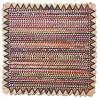Quilt No.964NGA - National Gallery of Australia
The quilt is padded with a layer of cotton wadding backed with a piece of tarlatan. The padding is only present beneath the patchwork panels and the bands that join them. There is no padding in the edge border of the quilt. The layers are quilted with machine sewing.
The quilt...
The quilt was made by 2 sisters, Miss Constance Bright and Miss May Bright in Tasmania about 1893. A member of the Bright family was employed by the Crosby Shipping Company in 1835. A descendant of the Crosby family, Miss Catherine Crosby, later owned the quilt and gave it to her niece, Miss Jean Brodie, in 1930. Miss Brodie, Queensland, donated the quilt to the National Gallery of Australia to mark the occasion of the Bicentenary in 1988.
"Miss Constance Bright (United Kingdom c.1812-Australia died c.1915) and Miss May Bright (United Kingdom born c.1813-Australia died c.1915) made this quilt. They were sisters who came to Sandy Bay, Hobart, with their family as free settlers in 1835. The Bright family came from Skiffington Hall, Leicestershire, England and was employed in Hobart by the Crosby Shipping Company in 1835���." [NGA]
Related Quilts:
2650 x 1573mm
The backing is maroon cotton. 1600 x 1600 mm.
1555 x 910mm
1735 x 1350mm
1645 x 1060mm






